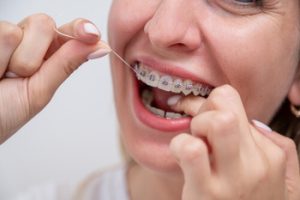When you hear the word “orthodontics,” your mind might jump straight to braces and teenagers with metallic smiles. But there’s much more to it. Orthodontics is a specific area of dentistry that focuses on correcting issues with the teeth and jaws, helping people of all ages achieve a healthier bite, improved function, and a more confident smile.
Let’s take a closer look at this exciting area of dentistry, covering what orthodontic treatment involves, how it works, and what you can expect on the journey to a straighter smile.
Understanding Orthodontics: More Than Just Braces
So, what is orthodontics exactly? At its core, orthodontics is a branch of dentistry that diagnoses, prevents, and treats dental and facial irregularities. These may include misaligned teeth, jaw alignment issues, crooked teeth, tooth wear, and more. It’s not just about aesthetics but also oral health and function.
Why Do People Need Orthodontic Treatment?
Orthodontic treatment isn’t just about achieving a perfect-looking smile. It plays a major role in your overall oral health and well-being. Many people seek treatment to correct dental problems like crooked teeth, crowded teeth, or gaps between other teeth, but the benefits go much deeper than appearances.
Here are some common reasons people turn to orthodontics:
1. Fixing Misaligned Bites
Issues like overbite, underbite, crossbite or open bite can cause discomfort when eating or speaking. Left untreated, they may lead to uneven tooth wear, jaw pain, or even long-term joint issues. Orthodontic treatment helps bring upper and lower teeth into proper balance for a functional and healthy bite.
2. Straightening Crooked or Crowded Teeth
When teeth overlap or twist due to lack of space, cleaning them properly is harder. This boosts the risk of tooth decay, gum disease, and bad breath. Straightening the teeth improves your smile and makes daily oral hygiene more effective.
3. Guiding Jaw Development in Children
Orthodontics can help guide the development of the upper and lower jaws in growing children, correcting growth patterns early on. This can prevent more serious dental and facial irregularities later in life.
4. Preparing for Other Dental Treatments
If you have missing teeth, misalignment can affect how your dentist replaces them. Orthodontics can create space or improve alignment before procedures like dental implants, bridges, or crowns.
5. Improving Speech and Chewing
Misaligned teeth or jaw issues can make it difficult to chew properly or speak clearly. Orthodontic treatment can improve how your teeth meet and move, enhancing both comfort and function.
6. Boosting Confidence and Self-Esteem
It’s also important to consider the emotional impact. Many people choose orthodontics to feel more confident about their smile. Straight teeth can boost self-esteem at any stage of life, whether it’s school pictures, professional settings, or social occasions.
Whether the goal is a cosmetic improvement, better function, or prevention of future problems, orthodontic treatment is a worthwhile investment in both your smile and your overall health.
Signs You Might Need Orthodontic Help
Are you or your child not sure if you need to see a dentist? Here are some common signs to look out for:
- Difficulty biting or chewing
- Crowded teeth or gaps between other teeth
- A noticeable overbite or underbite
- Misaligned upper front teeth
- Mouth breathing
- Clicking or popping sounds from the jaws
- Frequent biting of the cheeks or tongue
- Teeth that don’t meet correctly
A dentist can perform a clinical exam along with X-rays to assess whether treatment is necessary and recommend the most appropriate treatment option to suit your specific needs.
Common Orthodontic Appliances: What Are Your Options?
Dentists offer a wide range of tools to help move teeth into place. These include fixed appliances (which are attached to the teeth) and removable appliances (which can be removed when needed).
1. Traditional Metal Braces
These are the most recognisable type of orthodontic treatment. Traditional metal braces use brackets that are fixed to each tooth and linked by arch wires, which are regularly adjusted to gradually guide the teeth into better alignment. Elastic bands may also be used to improve jaw alignment.
2. Clear Aligners
Clear aligners, like Invisalign, are custom-made, nearly invisible trays that gradually shift teeth. They’re a great option for most patients who seek a more discreet way to straighten crooked teeth without brackets and wires.
3. Ceramic Braces
Similar to metal braces, the brackets are tooth-coloured or clear, making them less noticeable.
4. Lingual Braces
These are placed on the back of the teeth (the tongue side) so they’re not visible from the front.
5. Removable Retainers
After braces or aligners, removable retainers are often used to maintain the new position of your teeth.
6. Functional Appliances
These are often used in growing children to help guide jaw growth and improve the relationship between the upper jaw and lower jaw.
How Long Does Orthodontic Treatment Take?
There’s no one-size-fits-all timeline. The duration of orthodontic treatment varies depending on how complex the individual case is, the type of appliance used, the age of the patient, and how well the patient follows instructions.
On average, most treatments last from 12 to 36 months. Some patients may only need a few adjustments over a few years, while others with more complex dental issues may need longer treatment.
What Happens After Treatment?
After your teeth have been moved into their ideal positions, your dentist will provide you with retainers to keep everything in place. Without retainers, teeth can gradually shift back, especially in the first year post-treatment.
Removable retainers are common, though fixed retainers may also be used in certain cases. Wearing your retainers as instructed is crucial to protect your investment in your smile.
Benefits of Orthodontic Treatment: More Than Just Looks
While many people seek orthodontics for cosmetic reasons, there are important health benefits too:
- Decreases the likelihood of developing tooth decay and gum disease.
- Prevents abnormal tooth wear
- Improves chewing and digestion
- Enhances speech clarity
- Reduces tension in the jaw muscles and joints.
- Prevents long-term dental complications
- Boosts confidence and self-esteem
Properly aligned teeth are easier to clean, which helps reduce the risk of developing dental issues later on.
Orthodontics for Adults: It’s Never Too Late
Orthodontic treatment isn’t just for children. In fact, an increasing number of adults are turning to clear aligners and other modern options to improve their smile and bite.
Adults may require orthodontics for many reasons, including relapse from previous treatment, new dental issues, or a desire for cosmetic enhancement. With so many discreet options available, more patients are starting treatment later in life.
Are There Risks or Side Effects?
 As with any dental procedure, there can be side effects. These may include:
As with any dental procedure, there can be side effects. These may include:
- Temporary discomfort or soreness
- Irritation of the cheeks or tongue
- Difficulty eating certain foods
- Risk of cavities if oral hygiene is neglected
- Allergic reactions to metal components (in rare cases)
But with good care and regular check-ups, these risks are minimal.
What to Expect During Your Orthodontic Journey
Starting orthodontic treatment is a big step toward improving your smile, but knowing what lies ahead can make the process feel a whole lot smoother. Whether you’re getting traditional braces, clear aligners, or another type of orthodontic appliance, the journey typically follows a few key stages.
Let’s walk through what to expect from your first consultation to the day your new smile is revealed.
1. Initial Consultation: Getting to Know Your Smile
It all begins with a visit to the dentist. During this appointment, they’ll closely examine your teeth, bite, and jaw alignment. A clinical exam, X-rays, and digital scans or impressions are usually performed to fully understand your dental structure.
This visit gives you the chance to ask questions, express any concerns, and discuss what you hope to achieve. Your dentist will use the results to recommend the most appropriate treatment options for your situation.
2. Creating Your Custom Treatment Plan
No two smiles are alike, which is why your dentist will design a tailored treatment plan just for you. This plan will outline which orthodontic appliances you’ll be using (like traditional metal braces or clear aligners), how long your orthodontic treatment takes, and what kind of results you can expect.
The plan considers everything from crooked teeth, spacing issues, and jaw alignment to any dental issues that might impact your progress.
3. Getting Your Appliances Fitted
Once your plan is set, it’s time to begin. If you’re getting braces, the dentist will bond brackets to your teeth and attach archwires that will apply gentle pressure to gradually move your teeth. You may also be given elastic bands to help align your bite.
If you’ve chosen clear aligners, you’ll receive your first set of trays and instructions on how to wear and care for them. They’re designed to be worn for 20 to 22 hours a day and changed every one to two weeks.
4. Regular Check-Ups and Adjustments
You’ll have regular check-ins throughout your treatment, typically every 4 to 8 weeks. These visits allow your dentist to closely observe your progress and make adjustments as needed.
This might involve tightening wires, changing aligners, or modifying elastic bands. These adjustments ensure your teeth and jaws continue moving toward their desired positions.
5. Nearing the Finish Line
As your smile begins to take shape, your dentist will monitor the final stages carefully to ensure everything aligns perfectly. Treatment usually ends once your teeth are in proper alignment and your bite feels natural.
6. Retainers: Protecting Your Progress
Your journey isn’t quite over once your braces or aligners are removed. You’ll be given removable retainers (or sometimes fixed ones) to help keep your teeth in their new position. Wearing them as directed is key to maintaining your results for the long term.
Communication is essential throughout your orthodontic journey. Your dentist will guide you, answer your questions, and ensure that you feel confident every step of the way.
Tips to Get the Most Out of Orthodontic Treatment
- Follow your dentist’s instructions closely
- Maintain excellent oral hygiene
- Avoid sticky and hard foods if you wear braces
- Wear your retainers as prescribed
- Keep up with dental check-ups
- Be patient; results are worth the wait
Frequently Asked Questions
Is orthodontic treatment painful?
Some discomfort is normal, especially after adjustments, but it’s manageable and temporary.
Can I still play sports or instruments with braces?
Yes! Mouthguards and a little practice go a long way.
 What if I have missing teeth? Can I still get braces?
What if I have missing teeth? Can I still get braces?
Yes, orthodontics can work alongside restorative dentistry to prepare your mouth for implants or bridges.
Are braces better than aligners?
It depends. Traditional metal braces are better for complex cases, while clear aligners suit those looking for discreet treatment.
How much does orthodontic treatment cost?
Costs vary depending on your case and the appliances used. Many clinics offer payment plans.
Final Thoughts: A Straighter Smile Is Just the Beginning
Orthodontics is about so much more than just achieving a beautiful smile. It’s about improving your bite, aligning your upper and lower teeth, and ensuring your mouth, jaws, and gums function in harmony.
Whether you’re exploring options for your child or considering treatment for yourself, the journey toward a straighter smile starts with understanding your choices and finding the right team to guide you.
Book a consultation with Beyond Infinity Dental today at (02) 8806 3799 to explore personalised orthodontic solutions that suit your needs and goals. Your path to a healthier, more confident smile starts here.
References
- American Association of Orthodontists. Common orthodontic problems. Retrieved from https://aaoinfo.org/resources/common-orthodontic-problems/
- Colgate. What causes crooked teeth? Retrieved from https://www.colgate.com/en-us/oral-health/adult-orthodontics/what-causes-crooked-teeth
- Healthline. Does Invisalign work? Retrieved from https://www.healthline.com/health/does-invisalign-work
- Cleveland Clinic. Teeth retainer. Retrieved from https://my.clevelandclinic.org/health/treatments/10899-teeth-retainer









